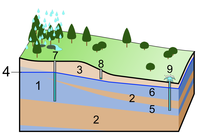
Photo from wikipedia
Abstract Between 2012 and 2015, a severe drought and the consequent decrease in water supply in the southeastern region of Brazil reached concerning levels, leading to a water crisis. This… Click to show full abstract
Abstract Between 2012 and 2015, a severe drought and the consequent decrease in water supply in the southeastern region of Brazil reached concerning levels, leading to a water crisis. This situation caused aerial exposure of some reservoirs drawdown zone. This study aims to measure methane fluxes emitted by this drawdown zone along the Funil hydropower reservoir, Rio de Janeiro, Brazil. It was observed that there was a temporal variation of the methane flux in the sediments exposed in the three scenarios studied: drought, flooding and full (0.43, −0.31 and −0.01 mg CH4 m-2 h-1, respectively). The CH4 flux by area in the scenario with the highest exposed sediment area was 0.195 ton CH4 d-1. Considering the values recorded, the contribution of these emissions must become considered in the overall balance of methane in the atmosphere as a new pathway by reservoirs, mainly with the expected forecasts and possible cycles of droughts that may occur frequently. However, the temporal variability of these fluxes indicated the need for future monitoring initiatives that seek to understand how climate change affects the biochemical processes within the exposed sediments of drawdown zones.
Journal Title: Journal of South American Earth Sciences
Year Published: 2019
Link to full text (if available)
Share on Social Media: Sign Up to like & get
recommendations!